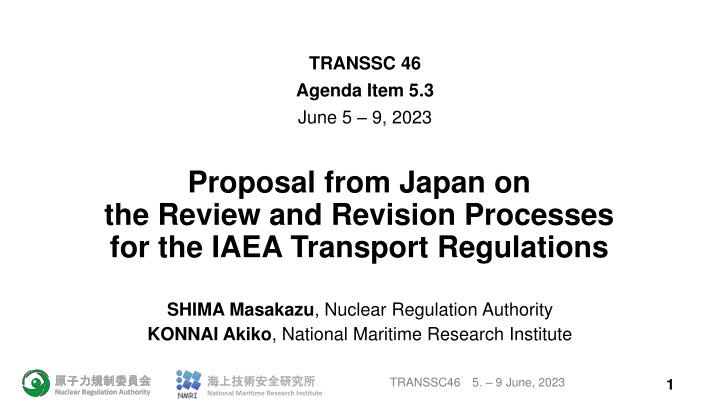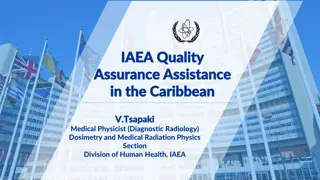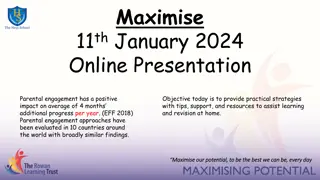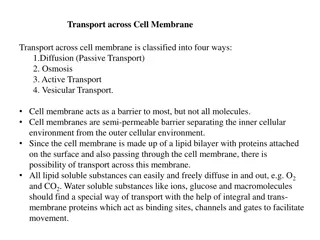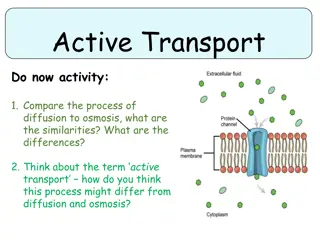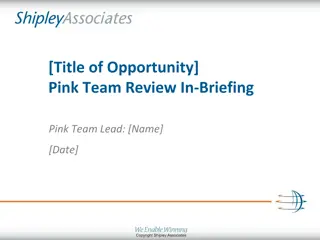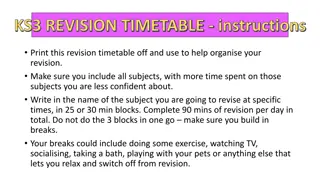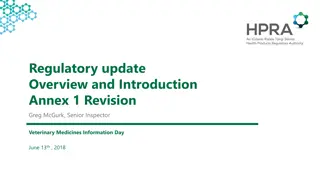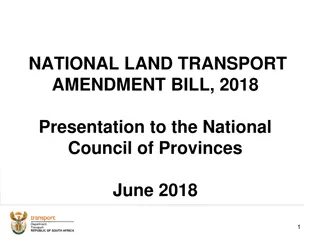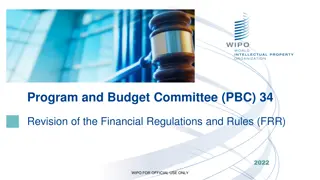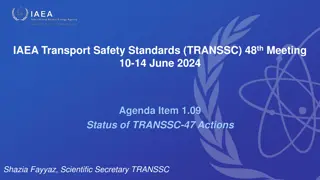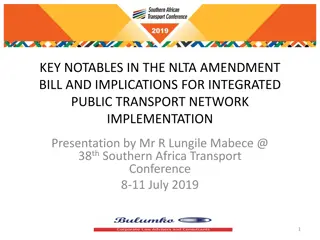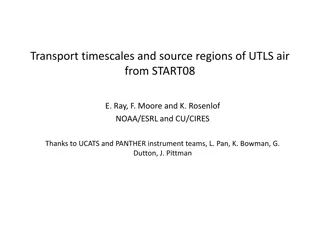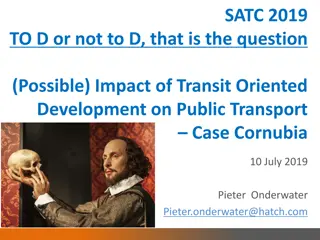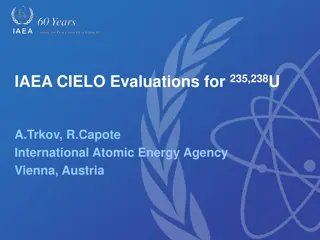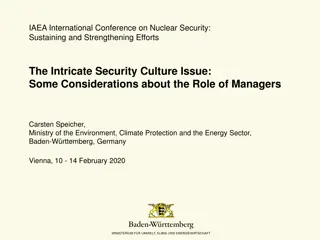Review and Revision Processes for IAEA Transport Regulations Proposal
The proposal from Japan advocates for a 2-year revision process for the IAEA Transport Regulations to align with international standards. The aim is quick implementation of new knowledge, reflecting changes from international regulations and standards, and efficient problem-solving. The process involves continuous review and periodic revision separate from review.
Download Presentation

Please find below an Image/Link to download the presentation.
The content on the website is provided AS IS for your information and personal use only. It may not be sold, licensed, or shared on other websites without obtaining consent from the author.If you encounter any issues during the download, it is possible that the publisher has removed the file from their server.
You are allowed to download the files provided on this website for personal or commercial use, subject to the condition that they are used lawfully. All files are the property of their respective owners.
The content on the website is provided AS IS for your information and personal use only. It may not be sold, licensed, or shared on other websites without obtaining consent from the author.
E N D
Presentation Transcript
TRANSSC 46 Agenda Item 5.3 June 5 9, 2023 Proposal from Japan on the Review and Revision Processes for the IAEA Transport Regulations SHIMA Masakazu, Nuclear Regulation Authority KONNAI Akiko, National Maritime Research Institute Nuclear RegulationAuthority Nuclear RegulationAuthority TRANSSC46 5. 9 June, 2023 National Maritime Research Institute 1
Prologue GOV/2005/31 The Board of Governors also approved a new policy for reviewing and revising the Transport Regulations. Under this policy, the Transport Regulations will be reviewed every two years (the current review cycle of the relevant international bodies), but the decision on an actual revision or publication will be made based on the assessments of the Transport Safety Standards Committee (TRANSSC) and the Commission on Safety Standards. At its September 2005 meeting, TRANSSC developed the criteria for conducting their assessment of the safety significance of proposed amendments. Nuclear Regulation Authority TRANSSC46 5. 9 June, 2023 National Maritime Research Institute 2
Contents Is it possible to conduct the revision process of the IAEA Transport Regulations in 2 years? Yes, it is, under the current SPESS process. How can we put it in practice? Periodical 2 year revision process To separate the review process from the revision process. The review process will be conducted constantly. Nuclear Regulation Authority TRANSSC46 5. 9 June, 2023 National Maritime Research Institute 3
Part 1 Is it possible to conduct 2 year revision process? Nuclear Regulation Authority Nuclear Regulation Authority TRANSSC46 5. 9 June, 2023 National Maritime Research Institute 4
Do we need 2 year revision of the IAEA Transport Regulations? To be consistent with the revision cycles of UNOB and other transport modal regulations. Timely input to the UNOB revision cycle seems mandatory TRANSSC feels comfortable with shorter revision process Merits of the 2 year revision process Quick implementation of new knowledge, such as addition of new radionuclides or new concept of package. Incorporation of changes of international regulations (UNOB, etc.) and international standards (ISO, etc.) Quick reflection of feedback from the Member States implementation of the Regulations Easy planning for problem-solving (in long/medium/short time) Nuclear Regulation Authority TRANSSC46 5. 9 June, 2023 National Maritime Research Institute 5
2 year process, possible? Under the current SPESS, the revision process can be conducted in every 2 years. TRANSSC/CSS/BoG decide to go 2 year revision process. Periodically initiate/close the revision processes (date fixed process) See the schedule in next page. SPESS specifies the process for the revision, not for the review. Separate the review process from the revision process. (Current review process is unique to TRANSSC) If the DPP is approved periodically (November, biennially odd years), the revision process can be completed practically in 2 years. Nuclear Regulation Authority TRANSSC46 5. 9 June, 2023 National Maritime Research Institute 6
Schedule for the 2 Year Revision Process Nuclear Regulation Authority TRANSSC46 5. 9 June, 2023 National Maritime Research Institute 7
DPP for the 2 Year Revision Process Step 3 : Approval of the DPP by November TRANSSC, in the first odd year Step 7 : Approval of the first draft by July TRANSSC in the first even year to Member States solicitation (August to November, 120 days) Step 11 : Approval of the final draft by July TRANSSC in the second odd year Step 12 : Endorsement of the final draft by November CSS in the second odd year Practical revision work by TRANSSC ends. TRANSSC can engage to the next revision process with approval of DPP for the next revision. Step 13 : Approval of the final draft by March BoG in the second odd year Changes of the Regulations will be noticed to UNSCETDG in Apri. Nuclear Regulation Authority TRANSSC46 5. 9 June, 2023 National Maritime Research Institute 8
Major Points to be Considered to Move to 2 Year Revision Process 1. To revise GOV/2005/31 to separate the review process and the revision process Efforts by Member States are required. 2. Approval of DPP in November TRANSSC in the first odd year The DPP should be a routine document with fixed dates, easy to be approved by CC/TRANSSC/CSS. 3. Approval of the first draft in July TRANSSC in the first even year Only matured proposals with clear text changes and justification should be supplied to the revision process. 4. Approval of the final draft in November TRANSSC in the second odd year Nuclear Regulation Authority TRANSSC46 5. 9 June, 2023 National Maritime Research Institute 9
Approval of DPP in every 2 years? 1. If it is decided to move to the 2 year revision process, the DPP will be a routine document to be approved without discussion. Dates that need TRANSSC action can be automatically fixed (Step 3, Step 7 and Step 11). 2. Can the next process initiated without closing the current process (Step 13 and 14)? TRANSSC revision work is practically closed in Step 12 (CSS endorsement). 3. What will be the document to be revised in the next process? SSR-6_20X4 Edition, not published until the summer in 20X4. The final draft (i.e., DSxxx-Step12) is available to TRANSSC. It can be a Working Document to consider the revision. Nuclear Regulation Authority TRANSSC46 5. 9 June, 2023 National Maritime Research Institute 10
Will the first draft be readily available? 1. Only matured proposals should be supplied from the review process to the revision process. Need and justification of the proposed change are clear, and agreed in the review process. Clear regulatory text change is prepared. 2. Thus, the first draft can easily be prepared by bundling these matured proposals. 3. Member States can easily provide their 120 day comments to the proposals as they have been well discussed in the review process. Nuclear Regulation Authority TRANSSC46 5. 9 June, 2023 National Maritime Research Institute 11
Part 2 How to supply matured proposals to the Revision Process : Constant Review Process Nuclear Regulation Authority Nuclear Regulation Authority TRANSSC46 5. 9 June, 2023 National Maritime Research Institute 12
What is the problems with current Review/ Revision Processes? The process is initiated with a call for proposals for the review process, then continuingly move to the revision process under TRANSSC decision. It takes at least 3 to 4 years to revise the Regulations. Member States rush in proposing changes, since the departure of the next train for the Regulations change is unknown. Member States hurriedly conduct the review process with a mind starting the revision process as early as possible. Consequently, not-matured proposals may subject to the revision process, resulting longer process. Nuclear Regulation Authority TRANSSC46 5. 9 June, 2023 National Maritime Research Institute 13
Proposal of a Constant Review Process 1. Member States can submit change proposals at any time. 2. Proposals will be reviewed and discussed as long as being agreed and matured. Only agreed and matured proposals can be supplied to the revision process. Proposal judged as not-matured will be retuned to the sender for further elaboration. It may be achieved through works by TTEGs, Working Groups, Consultancy Meetings, Technical Meetings, or Coordinated Research Projects. Identified Problems with proposed solution path can also be accepted. Nuclear Regulation Authority TRANSSC46 5. 9 June, 2023 National Maritime Research Institute 14
How to Conduct the Constant Review Process Proposed? 1. Interval of process is set at 2 years for convenience to match the revision process, and each interval is divided into 4 sessions. Member States submit proposals any time, but the due date for submission is set for each session to aggregate proposals during that session. Proposals during that session are reviewed by TRANSSC whether they can be supplied to the revision process. Agenda to review the proposals will be prepared for TRANSSC Plenary. 2. 3. Criterion to accept the proposal is Is it agreed as matured?" 4. At the end of the fourth session, proposals approved by TRANSSC are integrated and sent to the revision process. 5. These process should be documented as a Quality Plan. Nuclear Regulation Authority TRANSSC46 5. 9 June, 2023 National Maritime Research Institute 15
Schedule for the Constant Review Process Nuclear Regulation Authority TRANSSC46 5. 9 June, 2023 National Maritime Research Institute 16
Proposed Contents of Quality Plan 1. Notification from the Secretariat to TRANSSC to initiate the review process for a duration of two years with a call for proposals (comments). 4 sessions are assigned (synchronize with the TRANSSC meetings) with due date of proposal submission for each session (60 90 days ahead of the TRANSSC meeting. 2. In each TRANSSC meeting, a slot to review the proposals submitted during that session is allocated. The proposals are reviewed by the TRANSSC Plenary under the agenda item Proposals Review with a length corresponding to the numbers of proposals to be reviewed. Criterion for approval: Is the proposal agreed as matured with clear change text, the needs and justification to be submitted to the revision process. 3. At the end of the fourth session, approved proposals are integrated and submitted to the revision process. Nuclear Regulation Authority TRANSSC46 5. 9 June, 2023 National Maritime Research Institute 17
Conclusion TRANSSC to consider this proposal Thank you for your kind attention. Nuclear Regulation Authority Nuclear Regulation Authority TRANSSC46 5. 9 June, 2023 National Maritime Research Institute 18
Annex 1: Stability of the Regulations What does Stability of the Regulation mean? To avoid frequent change of the same provision back and forth. It can be achieved by careful consideration to needs, the justification and impacts of proposals in the review process. Changes to incorporate new knowledge, to reflect MS feedback from the Regulations implementation are mandatory and inevitable. These changes are the evolution of the Regulations and TRANSSC experience tells that they have not affected the stability of the Regulations. Nuclear Regulation Authority TRANSSC46 5. 9 June, 2023 National Maritime Research Institute 19
Annex 2: Interface with the Modal Regulations Nuclear Regulation Authority TRANSSC46 5. 9 June, 2023 National Maritime Research Institute 20
